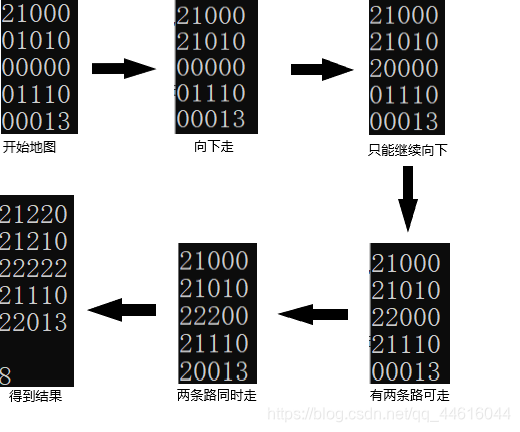简介
宽度优先搜索算法(又称广度优先搜索)是最简便的图的搜索算法之一,这一算法也是很多重要的图的算法的原型。其别名又叫BFS,属于一种盲目搜寻法,目的是系统地展开并检查图中的所有节点,以找寻结果。换句话说,它并不考虑结果的可能位置,彻底地搜索整张图,直到找到结果为止。
相信初次接触的人已经蒙圈了,那么我们先不要探究其代码,直接从这个算法的过程来观察它怎样运算
BFS常用于迷宫,即从一点到另一点的最短路径,所以这里以一个迷宫来说明:
这里有一个5*5的迷宫,1是墙,0是路,那么从左上角走道右下角最少需要多少步呢?
0 1 0 0 0
0 1 0 1 0
0 0 0 0 0
0 1 1 1 0
0 0 0 1 0
首先把终点设为3,走过的路设为2,可以得到这样的过程图:

从图中可以清楚地看到这个算法从(0,0)点开始,向不同方向走,到达指定条件就停止并返回结果
就是因为这个性质,先到达的那条路线一定是步数最少的,所以只要有一条路线走到了,那么它一定就是最短路线,直接返回,所以这个算法非常快(重点!重点!重点!)
代码
这就是上面那个问题的代码(带打印地图)
#include <iostream>
#include <cstdio>
#include <queue>
using namespace std;
int Map[5][5]; //定义地图大小
int dir[4][2]= {1,0,-1,0,0,-1,0,1}; //定义方向
int n,m,ans;
struct node
{
int x,y,step;
} now,nextt; //保存走步
int BFS(int x,int y)
{
queue<node>q;
int xx,yy,zz;
Map[x][y]=2; //走过初始点
now.x=x;
now.y=y;
now.step=0;
q.push(now); //从当前点开始
while(!q.empty())
{
now=q.front();
q.pop();
for(int i=0; i<4; i++) //遍历四个方向
{
xx=now.x+dir[i][0];
yy=now.y+dir[i][1]; //走一步
if(xx>=0&&xx<5&&yy>=0&&yy<5&&Map[xx][yy]!=1&&Map[xx][yy]!=2) //可以走
{
nextt.x=xx;
nextt.y=yy;
nextt.step=now.step+1; //步数加一
Map[now.x][now.y]=2; //走过一个点
if(Map[xx][yy]==3) //到达终点
return nextt.step;
q.push(nextt);
}
for(int i=0; i<5; i++){ //打印地图
for(int j=0; j<5; j++)
cout << Map[i][j];
cout << endl;
}
cout << endl;
}
}
return -1; //走不过去
}
int main()
{
for(int i=0; i<5; i++) //输入地图
for(int j=0; j<5; j++)
cin >> Map[i][j];
Map[4][4]=3; //定义终点
ans=BFS(0,0);
cout << ans<< endl;
return 0;
}
以上就是一个简单的BFS模板
例题
1.首先来看一个迷宫问题的变种
HDU-1072
这个问题相当于添加了步数限制,只需要把上面改动一下过程
#include <iostream>
#include <cstdio>
#include <queue>
using namespace std;
const int maxn=200;
int Map[maxn][maxn];
int dir[4][2]= {1,0,-1,0,0,-1,0,1};
int n,m,ans;
struct node
{
int x,y,step,z;
} now,nextt;
int BFS(int x,int y,int z)
{
queue<node>q;
int xx,yy,zz;
Map[x][y]=0;
now.x=x;
now.y=y;
now.step=0;
now.z = z;
q.push(now);
while(!q.empty())
{
now=q.front();
q.pop();
for(int i=0; i<4; i++)
{
xx=now.x+dir[i][0];
yy=now.y+dir[i][1];
zz = now.z-1;
if(xx>=0&&xx<n&&yy>=0&&yy<m&&Map[xx][yy]!=0 && (zz>1 || (Map[xx][yy]!=1 && zz==1)))
{
nextt.x=xx;
nextt.y=yy;
nextt.step=now.step+1;
nextt.z = zz;
if(Map[xx][yy]==4){
Map[xx][yy] = 0;
nextt.z = 6;
}
else if(Map[xx][yy]==3)
return nextt.step;
q.push(nextt);
}
}
}
return -1;
}
int main()
{
int sx,sy,o;
cin >> o;
while(o--)
{
cin >> n >> m;
for(int i=0; i<n; i++)
{
for(int j=0; j<m; j++)
{
cin >> Map[i][j];
if(Map[i][j]==2)
{
sx=i;
sy=j;
}
}
}
ans=BFS(sx,sy,6);
cout << ans<< endl;
}
return 0;
}
2.另一种变化
POJ - 1915
这个问题只需要在简单模板的基础上改一下走法就可以了
#include <iostream>
#include <cstdio>
#include <queue>
#include <cstring>
using namespace std;
const int maxn=301;
int Map[maxn][maxn];
int dir[8][2]= {-2,-1,-2,1,-1,2,1,2,2,1,2,-1,1,-2,-1,-2};
int l,sx,sy,lx,ly,o,ans;
struct node
{
int x,y,step;
} now,nextt;
int BFS(int x,int y)
{
queue<node>q;
int xx,yy;
Map[x][y]=1;
now.x=x;
now.y=y;
now.step=0;
q.push(now);
while(!q.empty())
{
now=q.front();
q.pop();
for(int i=0; i<8; i++) //注意八个方向
{
xx=now.x+dir[i][0];
yy=now.y+dir[i][1];
if(xx>=0&&xx<l&&yy>=0&&yy<l&&Map[xx][yy]!=1)
{
nextt.x=xx;
nextt.y=yy;
nextt.step=now.step+1;
if(xx==lx && yy==ly)
return nextt.step;
q.push(nextt);
Map[xx][yy]=1;
}
}
}
}
int main()
{
cin >> o;
while(o--)
{
cin >> l >> sx >> sy >> lx >> ly;
memset(Map,0,sizeof(Map));
if(sx==lx && sy==ly)
ans = 0;
else
ans=BFS(sx,sy);
printf("%d\n",ans);
}
return 0;
}
3.别的应用(连通块)
POJ - 1562
注意方向和BFS运用方法改变
#include <iostream>
#include <queue>
#include <cstdio>
using namespace std;
const int maxn=105;
char Map[maxn][maxn];
int n,m,cnt=0;
int dir[8][2]={{1,0},{1,1},{1,-1},{-1,0},{-1,1},{-1,-1},{0,1},{0,-1}};
struct node
{
int x;
int y;
}now,next;
void BFS(int x,int y)
{
now.x=x;
now.y=y;
Map[x][y]='*';
queue<node> q;
q.push(now);
while(!q.empty())
{
now=q.front();
q.pop();
for(int i=0;i<8;i++)
{
int xx=now.x+dir[i][0];
int yy=now.y+dir[i][1];
if(xx>=0&&xx<n&&yy>=0&&y<m&&Map[xx][yy]=='@')
{
Map[xx][yy]='*';
next.x=xx;
next.y=yy;
q.push(next);
}
}
}
}
int main()
{
while(~scanf("%d%d",&n,&m))
{
cnt=0;
if(n==0)///输入0 0 退出
break;
for(int i=0;i<n;i++)
{
scanf("%s",Map[i]);
}
for(int i=0;i<n;i++)
{
for(int j=0;j<m;j++)
{
if(Map[i][j]=='@')
{
cnt++;
BFS(i,j);
}
}
}
printf("%d\n",cnt);
}
return 0;
}
以上举了三个较简单的例题,能完全明白就了解了BFS的基础应用,还需要学会BFS的更多变种以及怎样与别的算法结合
